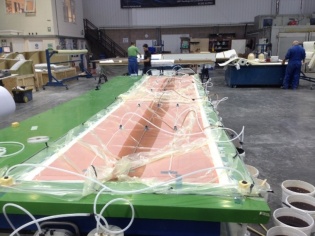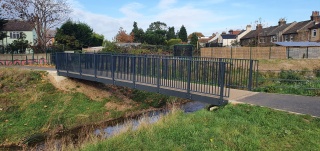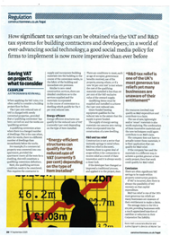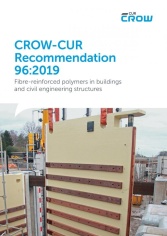Articles about CD368
Composite Bridges - A comparison between moulded and pultruded bridges.
/ Martin Richardson / CD368, Composite, Composite, CUR96, FRP Composites, FRP Composites, Lightweight, Pedestrian, Timber Footbridge
We have published a technical paper to help clients and specifiers understand the significant differences in terms of installation, performance and long term maintenance of the different types of FRP bridge solutions that are available. There are two generic types of FRP composite bridges and they have quite different performance characteristics and maintenance requirements, so it is important for clients to understand the differences at the procurement stage. Moulded bridge decks are generally manufactured in a mould with dry fibres laid in specific orientations with a core material to produce a sandwich construction.
Case Study - Albany Park Footbridges
/ Martin Richardson / CD368, CUR96, Cycleway, Footbridge, Footbridge, FRP Composites, Lightweight, Lightweight, Timber Footbridge
DESCRIPTION
The Client had already purchased 4 moulded FRP composite footbridges from Lifespan Structures since 2018 recognising that for a similar purchase price to a steel bridge the Lifespan bridge significantly reduces installation costs and future maintenance costs. For Albany Park Lifespan designed and delivered 2No. bridges each 12m long. One bridge was a pedestrian bridge 2m wide and the other one was for pedestrians and service vehicles 2.5m wide. Each bridge had galvanised steel, powder coated bespoke parapets to the Client’s design.
Case Study - Ockwells Park Footbridge
/ Martin Richardson / CD368, CD368, CUR96, Footbridge, Footbridge, FRP Composites, FRP Composites, PROW
The Client had recently purchased additional land to extend an existing park and wanted two footbridges across a small stream to gain access to the new land. Lifespan Structures recommended an FRP composite bridge supported on screw piles with a timber parapet to compliment the environmental location. The Client commissioned Lifespan to undertake a topographical survey, and borehole survey for the proposed locations. Lifespan then provided an Approval in Principle (AIP) for the Client and proceeded to design the two bridges followed by manufacture and delivery to site ready for installation.
New Botany Footbridge in Tonbridge
/ Martin Richardson / BD90/05, CD368, CD368, Composites UK, CUR96, Cycleway, Footbridge, Footbridge, FRP Composites, Pedestrian
Off site production allowed us to continue with this project during the lock down. Once restrictions were eased the existing bridge was removed and the foundations upgraded by CRL working for Kent Highways, before the new bridge was installed in June. KCC Cabinet Member for Highways and Transport, and Member for Tonbridge, Michael Payne said:
“This work was carried out to provide a strengthened and refurbished bridge to ensure it continues to be safe river crossing for the public to use. “The original deck was made from railway rails with a type of expanded metal mesh reinforcement, but unfortunately it wasn’t able to handle the number of people using it.
The use of an FRP Bridge could qualify for an R&D Tax Relief.
/ Martin Richardson / CD368, CD368, CUR96, CUR96, Cycleway, Footbridge, Footbridge, FRP Composites, Pedestrian
Very few people in the construction industry are aware of the significant commercial opportunity from identifying R&D processes and expenditure within the business. If a contractor has changed or improved a traditional process, and applied it to the project, then the resources involved may qualify as R&D expenditure and contribute to a claim. By offering an alternative construction technique using a Lifespan Structures composite deck, clients can often qualify for an R&D claim which will reduce the tendered costly of the scheme or enhance the profit margin.
CROW-CUR Recommendation 96:2019 - Now Available in English
/ Martin Richardson / BD90/05, CD368, CD368, CUR96, CUR96, Footbridge, Footbridge, FRP Composites, Pedestrian
The English Version of CUR96 is now available! CUR96 Recommendation describes the principles for the design of fibre-reinforced polymers (FRP)
It is available for download at https://crowplatform.com/product/crow-cur-recommendation-962019/
Please do contact us directly if you would like a to understand more about the content of this document.
The revised DMRB replaces BD90/05 with CD368
/ Martin Richardson / BD90/05, BD90/05, CD368, CD368, CUR96, CUR96, Cycleway, Footbridge, FRP Composites, Pedestrian
The DMRB was updated by Highways England just before the lockdown started. We were probably all distracted from noticing this at the time. The technical changes were substantial, especially regarding FRP bridges but the structure of the suite of documents changed. A summary of these changes can be seen at (https://standardsforhighways.co.uk/dmrb/help#new-structure)
One key change for us is the replacement of BD90/05 with CD368. CD368 updates the approach to FRP bridges. The new approach is now quite closely aligned with current European guidance documents.







